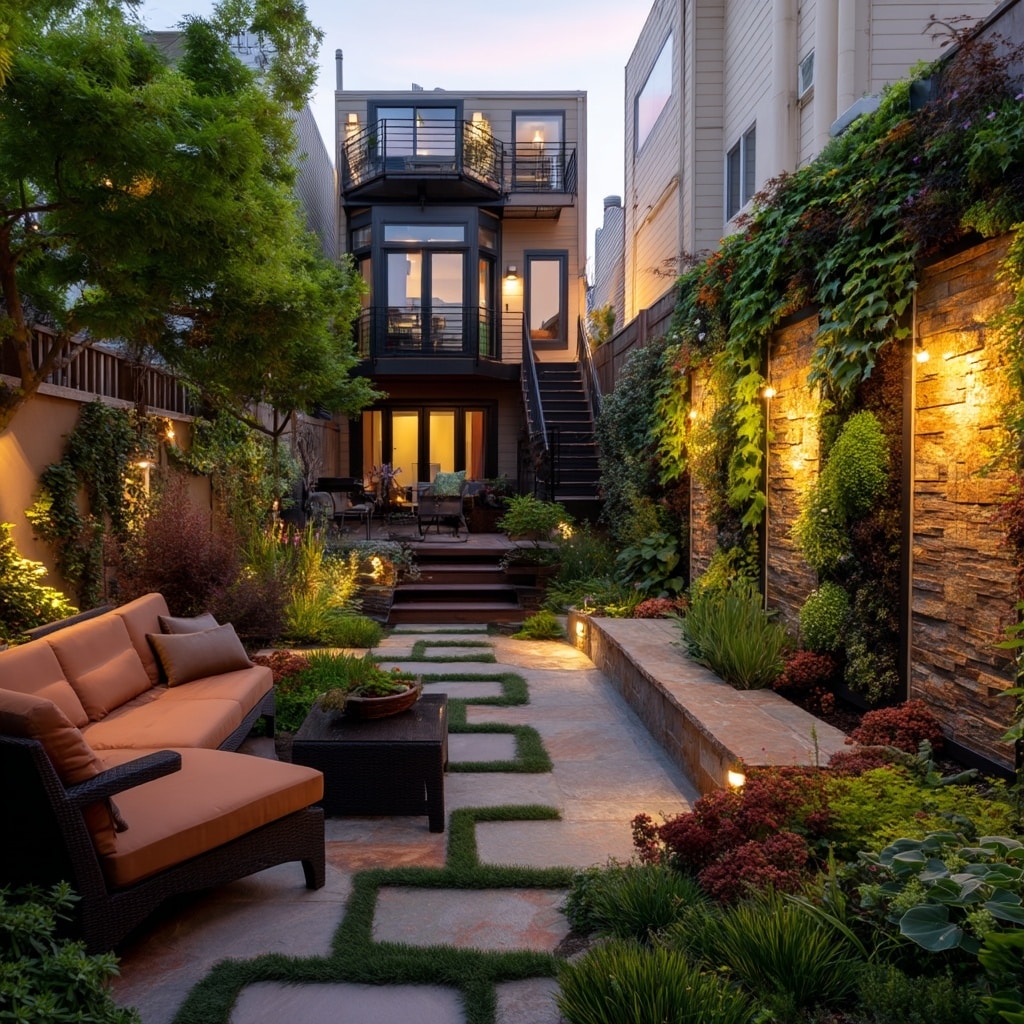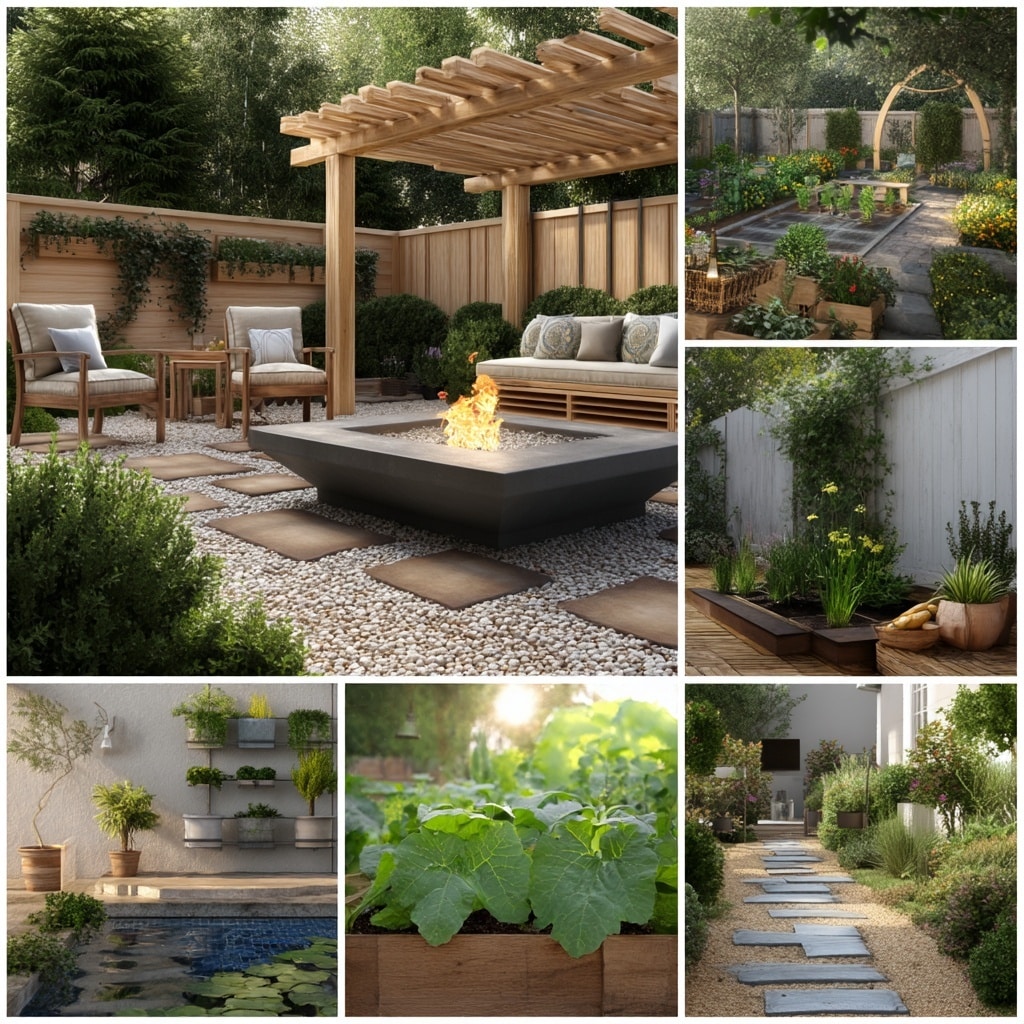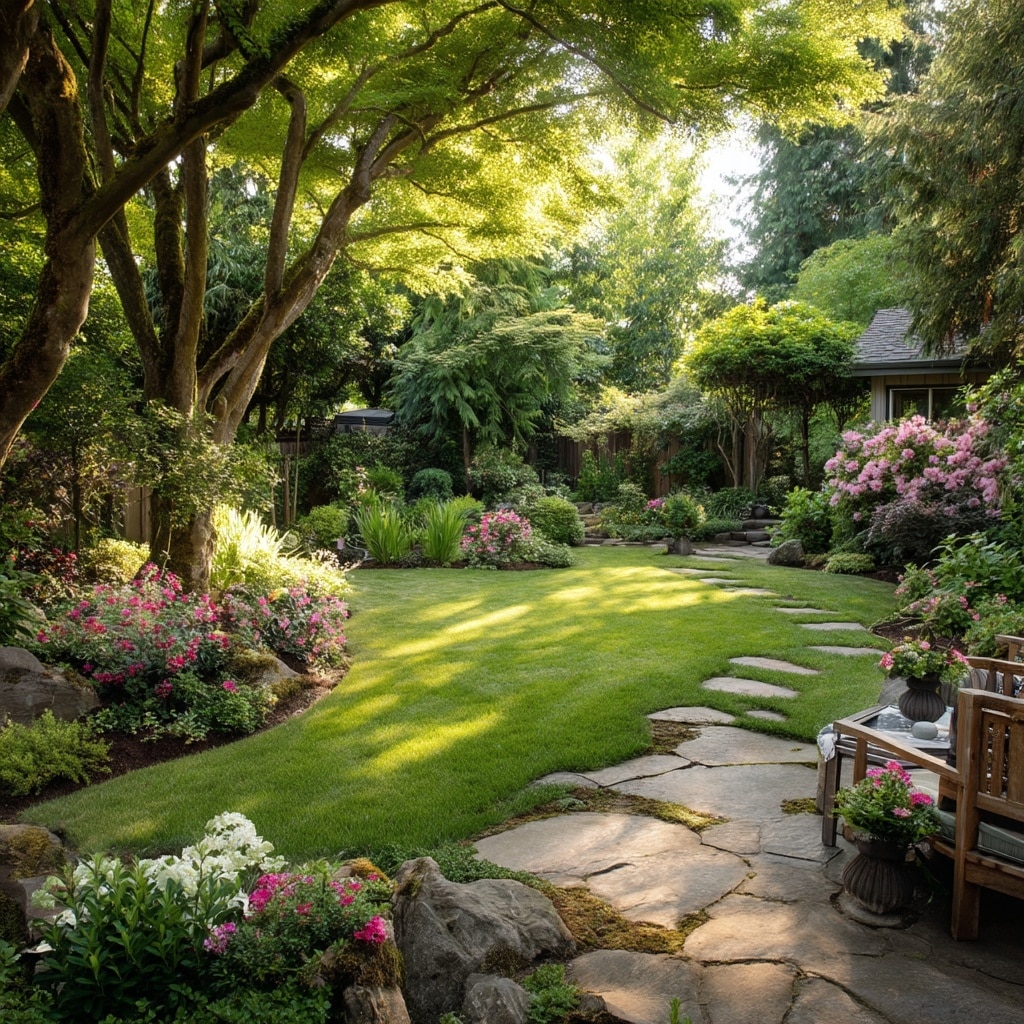Backyard landscaping is more than just planting flowers or laying sod — it’s about transforming your outdoor space into a personal retreat that reflects your lifestyle and enhances your home’s value. Whether you’re hosting family gatherings, relaxing with a good book, or growing your favorite vegetables, a well-designed backyard can make all the difference.
Today’s backyards serve as outdoor extensions of our homes, offering a blend of beauty, function, and comfort. Even the smallest spaces can be creatively redesigned to feel spacious, stylish, and practical. From planning the layout to choosing the right plants and features, thoughtful backyard landscaping brings structure, purpose, and peace to your outdoor experience.
In this guide, we’ll walk through essential design principles, practical planting tips, and real-life backyard ideas to help you create a landscape that’s both beautiful and usable — no matter your space or budget.
Table of Contents
Planning Your Backyard Living Space
Before diving into plants and patio furniture, smart backyard landscaping starts with a plan. Taking time to assess your space and set clear goals will ensure your yard works beautifully for the way you live.
Evaluate Your Space
Start by measuring your yard and observing its layout:
- Is it flat, sloped, or oddly shaped?
- What areas get full sun, partial shade, or remain damp?
- Are there mature trees or shrubs worth keeping?
Understanding these elements helps you make informed choices for design and planting.
Define How You’ll Use It
Ask yourself: How do I want to spend time in my backyard?
- Need room for kids or pets to play?
- Want to host barbecues or quiet evening dinners?
- Thinking about a vegetable garden, fire pit, or reading nook?
Identifying your top priorities allows you to organize the space with purpose — and still leave room for ornamental beauty.
Plan for Privacy
Even the most beautiful yard can feel exposed if it’s not private. Depending on your layout and surroundings, consider:
- Tall hedges or layered plantings to block views
- Lattice panels, trellises with vines, or pergolas for cozy enclosures
- Strategic fence placement to section off noisy or unsightly areas
Break It into Garden “Rooms”
Dividing your backyard into smaller functional zones creates a more inviting and spacious feel. Use pathways, planters, or changes in material (like gravel to pavers) to subtly separate areas like:
- Dining patio
- Play area
- Vegetable beds
- Lounge space
This structure makes even a small yard feel organized and intentional.
Match Style with Home Aesthetics
Choose hardscaping materials, outdoor furniture, and plants that reflect your home’s architecture. For example:
- Sleek, minimal designs pair well with modern homes
- Rustic wood and wildflower borders suit cottage-style houses
- Clean lines and neutral tones enhance mid-century or transitional homes
Sketch and Budget
Draw a rough layout of your ideas. It doesn’t have to be perfect — just a basic visual guide. For major projects, consider consulting a landscape designer.
Set a realistic budget before beginning. You can always phase the project over time, starting with high-impact areas and adding features later.
Planting & Caring for Your Backyard Landscape

A successful backyard landscaping plan doesn’t stop with structure — the right plants and smart care will bring your space to life season after season. Whether you’re building a pollinator haven or a private green retreat, your choices should support long-term beauty and ease of maintenance.
Start with Healthy Soil
Great gardens begin underground. If your yard is mostly turf or compacted from years of use, your soil likely needs help. Test the soil for pH, texture, and nutrient levels. Based on results, improve it with organic compost, aged manure, or soil conditioners to ensure drainage and fertility.
Tip: Raised beds or island beds are a great way to improve growing conditions in challenging areas.
Choose the Right Plants
Select plants based on your light, soil, and climate. Consider mixing:
- Trees and shrubs for privacy, shade, or structure
- Perennials and groundcovers for long-lasting color
- Annuals for seasonal brightness in pots or borders
- Native plants to attract birds, butterflies, and beneficial insects
Aim for variety — in height, texture, color, and bloom time — to keep your garden interesting year-round.
Layer Your Landscape
Use a tiered planting approach for a more natural, visually appealing layout:
- Tall trees in the background
- Shrubs or ornamental grasses in the mid-layer
- Perennials and groundcovers in the front
This creates depth and makes even small backyards feel lush and expansive.
Consider Maintenance Needs
Every plant and material has a maintenance price. Be honest about how much time you’re willing to spend weeding, pruning, and watering.
- Low-maintenance choices include mulch-covered beds, drought-tolerant perennials, and slow-growing shrubs.
- If you’re short on time, avoid high-maintenance lawns or overly complex plantings.
- Hiring occasional help for cleanup or mowing can keep your space enjoyable without becoming a chore.
Support Pollinators and Wildlife
Include plants that offer nectar, seeds, or shelter. Coneflowers, salvia, bee balm, and milkweed are great for bees and butterflies. Berries and dense shrubs attract songbirds, while layered plantings offer nesting spots.
Backyard Design Considerations

Once you’ve planned the layout and chosen your plants, it’s time to focus on the details that turn your yard into a comfortable, functional retreat. These considerations ensure your backyard landscaping isn’t just beautiful — it’s livable, safe, and sustainable.
Think About Flow and Function
Your outdoor areas should be easy to navigate and enjoyable to use. Make sure:
- Pathways are wide enough (ideally 3 feet or more)
- There’s clear access between your back door, cooking area, and dining space
- Seating zones have enough clearance for people to move around chairs or tables without feeling cramped
Design each space for the activity it serves — keep high-traffic zones durable and soft surfaces under quiet sitting areas.
Use Durable, Long-Lasting Materials
Backyards are exposed to sun, rain, and foot traffic. Invest in the best materials your budget allows:
- Weather-resistant furniture
- Natural stone or high-quality composite decking
- UV-resistant fabrics and cushions
- Permeable pavers to improve drainage
Long-lasting materials often save money in the long run by reducing repairs or replacements.
Layer Your Plantings for Privacy and Interest
Creating visual depth and screening is key, especially in urban or suburban settings. Layer plants in varying heights:
- Tall shrubs or ornamental trees for background privacy
- Mid-size perennials or grasses to soften borders
- Groundcovers to prevent erosion and fill gaps
This layered look is not only beautiful but also creates habitat for wildlife.
Go Vertical in Small Spaces
If your backyard is compact, grow upward. Add:
- Trellises or arbors with flowering vines
- Hanging baskets or wall planters
- Vertical herb gardens near your kitchen or grill
Vertical elements draw the eye upward, making small spaces feel larger and more vibrant.
Light the Space for Evening Use
Outdoor lighting extends your yard’s usability past sunset and adds ambiance. Mix lighting types for the best effect:
- Pathway lights for safety
- String lights or lanterns for mood
- Uplighting to highlight trees or architectural elements
Solar and LED options make lighting efficient and eco-friendly.
Use Containers Creatively
Containers aren’t just for patios — use them to:
- Accent transitions between spaces
- Introduce seasonal color
- Elevate focal points like doors or seating nooks
Try grouping pots in different sizes or materials for a curated, layered look.
Keep Safety in Mind
Especially important for homes with kids or older adults:
- Ensure steps, pavers, and decks are level and secure
- Use non-slip materials in damp zones
- Add lighting along stairs and dark corners
- Regularly check for hazards like loose boards or overgrown paths
Don’t Forget the Finishing Touches
Personalize your landscape with small artistic details:
- Sculptures, birdbaths, or mosaics
- Weatherproof wall art or wind chimes
- A cozy hammock or a decorative rain chain
These finishing elements reflect your personality and make the space truly feel like home.
Backyard Landscaping Ideas & Inspiration

When it comes to backyard landscaping, real-life examples can spark fresh ideas and help you visualize what’s possible in your own space. Whether you have a sprawling lawn or a small urban patch, these inspiring layouts show how thoughtful design can create beauty, function, and a sense of retreat.
1. Create Garden “Rooms” with Purpose
Dividing your backyard into separate zones gives each area a unique role — and makes your space feel bigger and more organized. Popular zones include:
- A cozy seating nook under a pergola
- A sunny dining area near the kitchen
- A playful kids’ corner with a sandbox or climbing frame
- A peaceful meditation spot with soft grasses and stone pathways
Use hedges, planter boxes, or trellises to define spaces while keeping the overall design cohesive.
2. Outdoor Kitchens and Entertaining Spaces
Bring the heart of the home outdoors by adding:
- A built-in grill station or pizza oven
- Bar-style seating for casual meals
- A durable dining table with weather-resistant chairs
Surround these areas with potted herbs or flowering borders for added charm and aroma.
3. Small Yards, Big Impact
Even tiny backyards can become lush oases:
- Use vertical gardens to maximize greenery
- Opt for multi-use furniture with storage
- Choose compact, dwarf plant varieties for borders and containers
- Install a fold-down table or bench for flexible use
Keep color palettes simple and coordinated to avoid visual clutter.
4. Eco-Friendly Backyard Design
Sustainable backyard landscaping benefits both you and the environment:
- Use permeable pavers and gravel for better drainage
- Replace thirsty lawns with low-maintenance native plants
- Add a rain garden or green roof on a shed
- Include a compost area to recycle garden waste
These features can reduce water use, lower maintenance, and attract pollinators.
5. Add Water Features for Peace and Movement
The sound of flowing water transforms a yard into a tranquil escape. Depending on your space:
- Add a fountain or birdbath for a focal point
- Install a pond to support aquatic plants and wildlife
- Consider a small waterfall to mask noise in urban settings
Make sure water features are child-safe and professionally installed when needed.
6. Make It Cozy with Fire Elements
A fire pit or outdoor fireplace allows you to enjoy your backyard year-round:
- Add a portable fire bowl for flexibility
- Build a stone fireplace for a more permanent setup
- Surround with comfy seating and soft lighting for ambiance
Remember to follow local fire safety regulations.
7. Personalized Backyard Retreats
Express your personality with unique features:
- A whimsical she-shed or artist studio
- Custom tile mosaics or handmade sculptures
- A hammock corner surrounded by fragrant flowers
Your backyard should reflect how you want to feel — energized, peaceful, playful, or all of the above.
Final Thoughts on Backyard Landscaping

A well-planned backyard landscaping design turns your outdoor space into a true extension of your home — a place to relax, entertain, and reconnect with nature. By evaluating your space, choosing the right plants, and designing with intention, you can create a backyard that suits your lifestyle and grows more beautiful over time.
Whether you’re working with a small urban lot or a large suburban yard, remember: great design doesn’t rely on size — it’s all about thoughtful planning, personal touches, and consistent care.
Ready to get started? Begin with a sketch, focus on your priorities, and enjoy the process of transforming your backyard into a place you’ll love for years to come.





